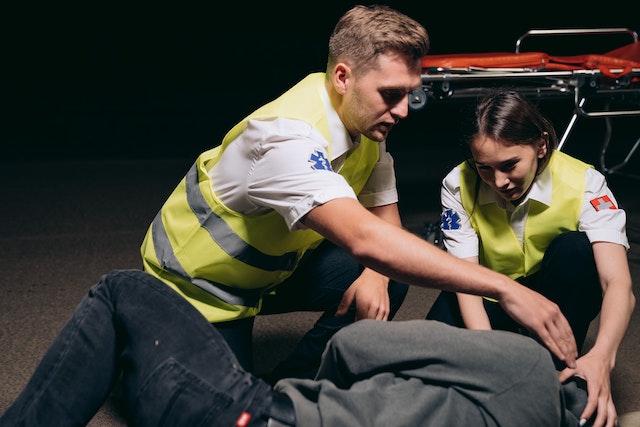Every second counts in an emergency, and as an EMT, you must know a patient’s state as soon as you get to them. This is why the sternum rub is a crucial method in assessing a patient’s level of consciousness and promoting breathing.
Find out why sternum rubs are important, when, and how to perform them effectively.
What Sternum Rub Means
Sternum rub is a technique to test an unconscious person’s responsiveness. It involves giving a firm rub on the sternum (the flat bone in the middle of your chest) to see if there’s a reaction. It’s a painful or noxious stimulus meant to provoke a response.
When someone is unresponsive to gentler attempts at interaction, like talking to them or giving them a gentle touch, a sternum rub can be a way to see if they’re still alive. It’s often useful when someone loses consciousness due to a brain injury or an overdose.
The Glasgow Coma Scale, a common neurological assessment used in healthcare, includes a sternum rub as one of its components.
Understanding the Sternum Rub Technique
A sternum rub involves rubbing the sternum vigorously with your knuckles while closing your fist. This is supposed to create pain, and if the patient doesn’t respond within a few seconds, you can conclude that they’re unresponsive and their brain might not be functioning properly.
However, here’s something interesting – some nurses and physicians on neurology floors have found that some patients need up to 30 seconds of continuous sternum rub to respond!
So, if you only apply the sternum rub for a few seconds and the patient doesn’t respond, it might not mean they have a compromised brain. It could just be that you didn’t apply the pressure correctly.
6 Reasons a Sternum Rub Is Important
Here are six reasons sternum rubs are important in EMS.
1. Assessing Cardiac Function
One of the primary reasons for performing sternum rubs is to assess cardiac function. Applying pressure on the sternum lets you determine if a patient’s heart is beating effectively.
2. Indicating Level of Consciousness
Sternum rubs can also help determine a patient’s consciousness level. Patients who respond to it are conscious and aware of their surroundings.

3. Checking for Pain Response
Another important use of sternum rubs is to check for pain response. If a patient reacts, it may indicate that they’re experiencing pain and require further evaluation and treatment.
4. Evaluating Neurological Function
In addition to cardiac function and pain response, a sternum rub can help you evaluate neurological function. A patient’s reaction to it may indicate that their neurological function is intact.
5. Access Severity of Emergency Situations
Sternum rubs are frequently used in emergencies, especially when a patient is unresponsive or in cardiac arrest. They can help determine the severity of the patient’s condition and guide appropriate treatment.
6. Non-Invasive
Sternum rubs are a non-invasive method of assessing a patient’s condition. They do not require special equipment or instruments, making them a quick and easy way to get important information on the patient’s state.
How to Perform a Sternum Rub
Performing a sternum rub requires precision. And with the follow these steps, you can do it effectively.
Step 1
Examine the sternum and avoid rubbing if there’s any recent surgery or injury in the area.
Step 2
Make a tight fist and rub your knuckles firmly up and down the person’s sternum with controlled pressure. Remember not to exert excessive force to prevent bruising.
Step 3
Continue the rub with consistent pressure until the person responds. Limit the rub time to 30 seconds.
Step 4
Observe for any reaction. This could be a slight movement of the hands or feet, indicating a response to the stimulation. The person may even reach out to stop the pain.
Remember to stay alert and be ready to take the appropriate action in response to the person’s reaction.
When to Avoid Sternum Rubs
As an EMT, you should only perform sternum rubs in an emergency where the person is not responding, is not breathing, and has no pulse. Opt for less invasive methods first and only escalate if you need to. Here are instances where you should avoid sternum rubs.
When Administering Sternum Rub to Intoxicated or Sedated Patients
When dealing with intoxicated or sedated patients, you must exercise caution when administering a sternum rub. The depressant effects of alcohol or certain drugs can dull their response, making it difficult to assess their consciousness level accurately.
So, consider the patient’s condition before proceeding with this method. Also, avoid performing a sternum rub if there’s a presternum abrasion or risk of bruising.
When the Patient Has Had a Recent Open Heart Surgery
Be mindful of performing a sternum rub on people who have recently had open heart surgery through their sternum. A sternum rub can irritate the incision and lead to complications such as infection or reopening the surgery wound.
Patients with Severe Injuries or Suspected Rib Fractures
Be careful when considering a sternum rub for individuals with multiple severe injuries or suspected rib fractures. It may worsen their injuries and cause additional pain. Always prioritize the safety and well-being of the person when choosing the most appropriate pain stimulus.
Alternative Methods to Sternum Rubs
Instead of using a sternum rub, you can use two other methods to apply a painful stimulus to the body’s core.
- The trapezius pinch
- Supraorbital pressure
These methods are quick and effective. Also, you’ll only need to apply them for up to 30 seconds to interpret the results accurately.
Performing the Trapezius Pinch
To perform a trapezius pinch, follow these steps:
- Grasp the trapezius muscle at the base of the neck with your thumb, index, and middle fingers.
- Then, squeeze and twist it to induce significant pain.
- Observe the patient’s facial expression and hand and arm movement for any signs of discomfort or attempt to remove the stimulus.
Performing the Supraorbital Pressure Method
Here’s how to perform the supraorbital pressure method:
- First, locate the bony ridge above the eye socket and carefully place your thumb along the midline.
- Apply upward pressure, which will cause severe pain and discomfort, and observe the patient’s response.
Join Elite Ambulance’s EMT Team Today!
Become a part of Elite Ambulance’s EMT team and start saving lives! We’re actively seeking dedicated and passionate individuals who have completed their EMT training and are ready to put their skills to use.
If you’re looking for a rewarding career in emergency medicine, apply now to join the Elite Ambulance team. Take advantage of this exciting opportunity to make a difference in your community.
Take the first step towards a prosperous career in EMS today!
Comments are closed.




Recent Comments